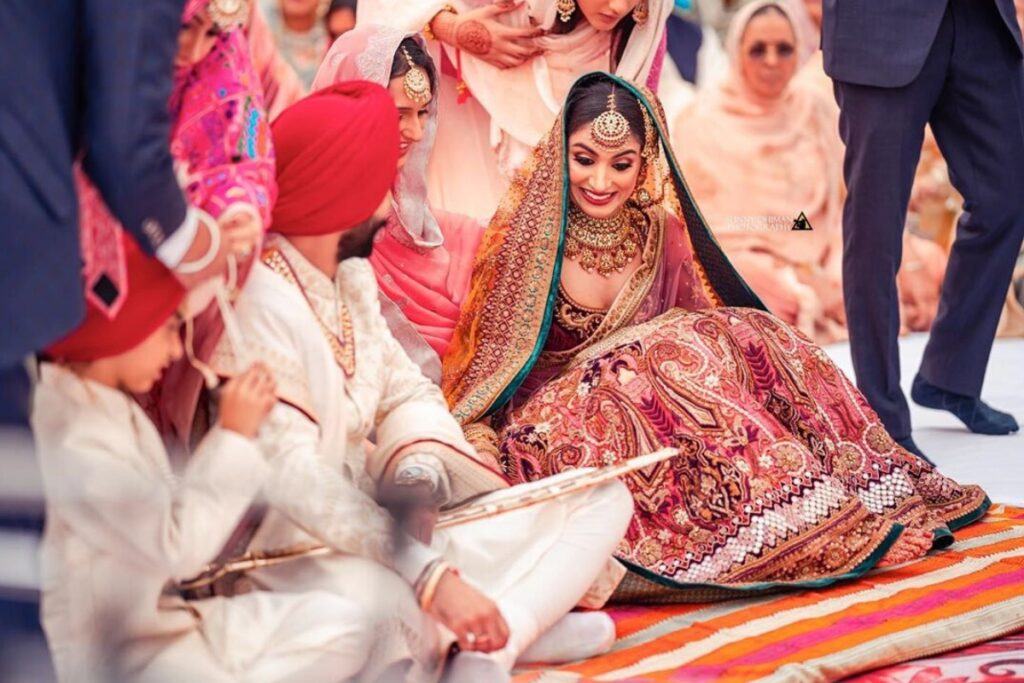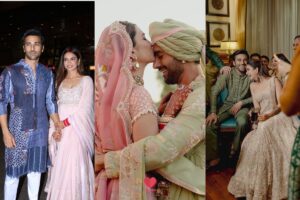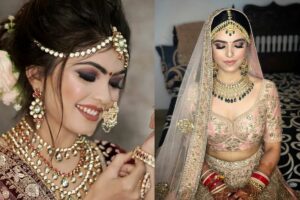Set amidst the broad daylight with bride & groom seated in front of Guru Granth Sahib and guests seated gender-wise for a quaint & sacred Anand Karaj ceremony is a picture everyone’s familiar with! But what really happens at this scenic and culturally rich wedding? Sikh wedding traditions and rituals all have beautiful symbolism and can mesmerize anyone who’s not a part of the culture. Find the highlights of a Sikh wedding decoded in this blog:
Sikh Wedding Traditions
-
Kurmai
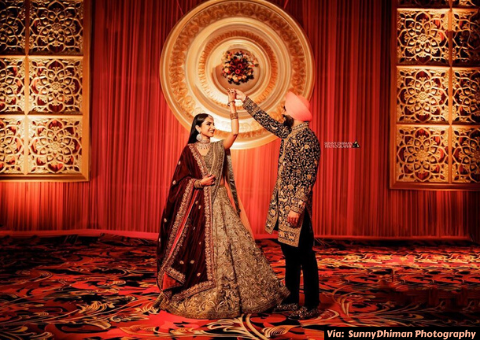
A Sikh engagement ceremony is called ‘kurmai’. This is done after a roka – which essentially seals the deal between the couple and before Anand Karaj. This one of the beautiful Sikh wedding traditions is done either at the groom’s house or the Gurudwara. The groom’s sister puts a red palla (dupatta) on his shoulders which opens in his lap. The bride’s father fills this palla with dry fruits, money, fruits, and other gifts. Afterward, the groom-to-be presents his woman with a ring and the bride’s family presents him with a silver or gold kara (hand bangle) and a kripan, a small knife symbolizing Sikh’s moral duty of protecting those in need and fighting any sort of injustice. The kurmai custom basically welcomes the groom to the family and declares that the family now has a son-in-law. It is quite similar to the Chunni ceremony, which is detailed next.
-
Chunni Ceremony
A few days before the wedding, the groom’s female relatives visit the bride’s house and present her with a red dupatta, clothes, jewelry, and other gifts. The groom’s mother or sister places the red dupatta over the bride’s head as a veil and other family members take turns to present the blushing bride with any gift of their choice from the lot as part of the Sikh wedding traditions. The gifts also include the lehenga which the bride will wear to her Sikh wedding or Anand Karaj, along with jewelry. Although she will have to don the outfit, she can mix & match the jewelry to create a set of her own. This ceremony basically strengthens the ties between the two families and welcomes the bride to their side of the family. The red color signifies prosperity and fertility in our culture, and thus, it’s the most common shade on Indian brides.
-
Jaggo
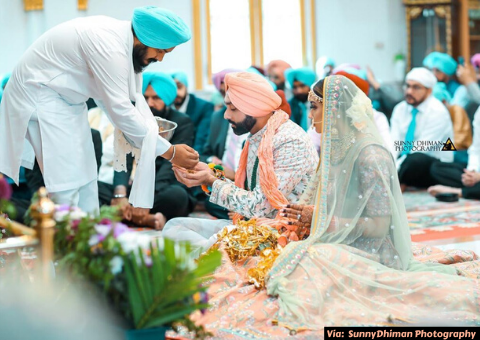
Jaggo ceremony is performed a day or two before the wedding day and generally collides with the mehendi ceremony. It’s done by the maternal families of both bride & groom. Jaggo basically means ‘wake up’ and denotes the start of the wedding festivities and getting into the celebratory mode. Here, the maternal families arrive at the beautifully decorated house of bride & groom, where they’re welcomed and served with delicious food. The entire ceremony is all about dancing, fireworks, and hearty banter. An ought-to ritual in Jaggo is female relatives dancing with a decorated earthen pot and a decorated stick with bells taking turns.
-
Maiya
Maiya is a part of both Sikh wedding traditions and Punjabi weddings. It starts 2 days before the wedding and during this time both the bride and groom aren’t allowed to leave the house. Within these 2 days, many rituals are scheduled like mehendi, jaggo, choora (where the bride’s maternal uncles present her with a bridal chooda set), gaana (in this, a red thread is tied to the bride’s left and groom’s right hand to protect them from the evil eye), and vatna or the traditional Haldi ceremony. However, unlike in other cultures where the Haldi is just done once, the ubtan application is done thrice for both the bride and the groom. One is done two days before the wedding in the morning and that basically is the start of the Maiyan, making a lot of people confuse Maiyan with the Haldi ceremony in Sikh culture. The second is done a day before the wedding in the morning, and the last one on the same day night.
-
Baraat
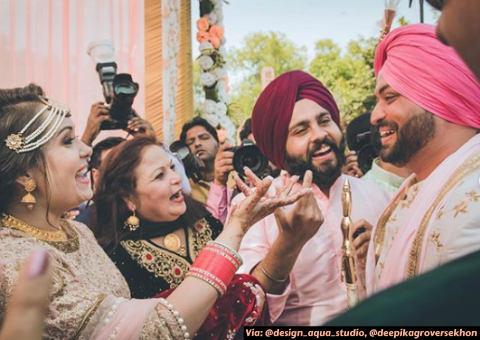
A baraat procession is a common Sikh wedding rituals and is a part of many Hindu weddings as well. The groom, all dressed up, is accompanied by his family members to the wedding venue. Quite in a fun & traditional way though. There are dhol players in the baraat, who play different songs & music as the family dances merrily while inching towards the Anand Karaj venue. Traditionally, the groom is seated on a horse, but now they also come the millennial way, like vintage cars and motorcycles. When the family reaches the location, the bride’s sisters and close friends tease and ask for ‘shagun’ before they let the entire baraat inside. This is just a cheeky Sikh wedding ritual signifying the groom taking away the bride by *earning* her way to her.
-
Milni
A Milni ceremony entails the bride’s side of the family welcoming the groom’s and presenting them with cash and gifts, oldest to youngest. The ceremony is all about the two families getting acquainted with each other individually and seeing how they’re related to the couple. A warm beverage like chai (masala tea), coffee, etc. is generally served as a welcome drink. Following the milni, the groom is seated in front of the Guru Granth Sahib and the bride enters shortly afterward, assisted by her father or brother, and sits on the left side of the groom.
-
Kirtan
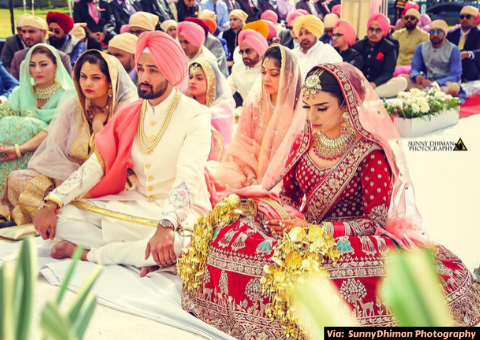
Kirtan, also known as Laavan da Kirtan, is sung recitations of the holy text, Bani. The singing is assisted by three musical players – a tabla player and two harmoniums. They are treated with the utmost respect as they are playing for the holy scripture. These musicians are part of the Gurudwara team and are often present at weddings done at the place. Given the globalization of weddings, and many Sikh weddings taking place in the US, UK, Canada, and other places – an English translation of these hymns are offered so they can be a part of the celebrations and understand what’s going on! During this time, the celebration turns to a more religious vibe than celebratory. The couple understands the sacredness of the bond they’re about to enter and prepares them to form a promise between one another.
-
Ardaas & Sikhia
Post Kirtan is another significant ritual in a Sikh Wedding called sikhia. In this aspect, the officiating member of the community guides the bride & groom with the wisdom and experience they’ll need during their married life together. The priest apprises that the union is between the two of them, but also between them and the Guru Granth Sahib. He can address the bride & groom separately to explain their mutual obligations as husband and wife. The groom is asked to respect and listen to the bride’s parents, take her to consult in terms of life outside the home (work-related preferences), and consider them one soul tied with love in two bodies. The bride, on the other hand, is asked to show faithfulness, respect, and love to her husband and also his family members so they can both thrive in their sacred union.
Sikhia is followed by Ardaas, a prayer that is recited by Sikhs on a daily basis. The entire congregation stands to offer these prayers to their Guru and reflects on their inner values. Additional prayers, such as vaak or hukam, may also be read at this time by opening a random page in the sacred text and starting to read from the right-hand side. One ardas is performed at the beginning just after sikhiya and the other at the end, right before kara prashad is served.
-
Laavan
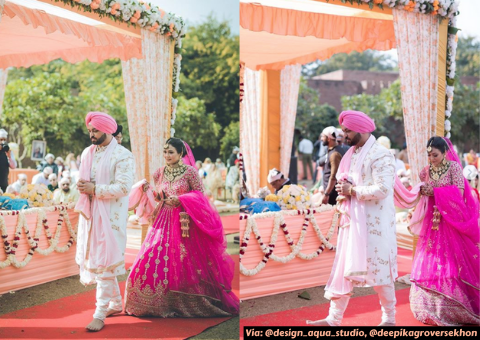
Laavan is pheras in an Anand Karaj. There are only 4 pheras in the Sikh wedding traditions, as opposed to 7 in other North Indian cultures. Before the Laavan, the bride’s father comes and places a dupatta in her daughter’s hands and presents the other end of the pallu to the groom. This is done while a hymn is sung by the priests and this sweet, emotional moment is referred to as the pallu ceremony. The officiator then announces that ‘the laavan path will begin’ and the bride & groom are asked to circle around the ‘Guru Granth Sahib’ clockwise. After each round, they listen to the path and say a short prayer. As the couple does the laavan, the bride’s close male relatives stand behind the Guru Granth Sahib and tap her shoulders, implying passing along their daughter to the groom’s family. After a couple more hymns and formalities, the priest announces Shadi ho hate, which basically translates to the wedding ceremony has been completed. This is followed by another short prayer (ardas) and the officiating member reading from the Guru Granth Sahib, in which the bride, groom, and family members listen intently as it dictates the significant meaning of their lives. In the end, the priest shouts ‘Vahe Guru Ji Ki Khalsa, Vahe Guru Ji Ki Fateh’ and the other members can join in this sacramental cheering.
-
Kara Prashad
At the closing of the Guru Granth Sahib, kara prasad (wheat halwa) is served to the congregation by a group of men – either from the Gurudwara or family members. To receive, you will be given a napkin and should cup your hands together, just like in a prayer, to show respect to this sacred offering. After the guests have dispersed, they go straight to the langar (community kitchen) where lunch is served. The menu in the Gurudwara doesn’t include meat and alcohol as it’s banned by the religion. Although, the reception and other wedding events do serve them.
Things To Keep In Mind While Attending A Sikh Wedding
Cover Your Head
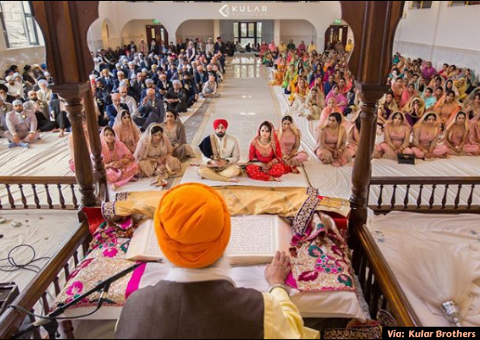
Before entering a Gurudwara, it’s a MUST that you cover your head with a pallu or dupatta if you are a woman or a bandana if you are a man. Absolutely no one is allowed to enter a gurudwara without their head covered. Also, it’s best that you are dressed ethnically and conservatively.
Remove Your Footwear
Anand Karaj takes place in a Gurudwara, a holy place of worship for Sikhs. It’s customary that you remove your shoes and sandals before entering the ceremony.
Keep Mum
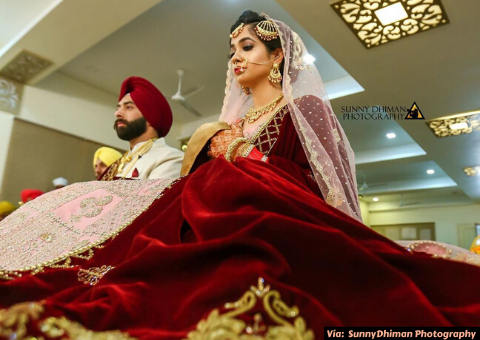
During the entire ceremony, it’s advised you don’t speak to each other (loudly) or put your phone on a ringer mode. The Anand Karaj takes around 2 hours to finish, and it’s respectful if you keep mum during this time. Rarely there’ll be silence in the area though, because hymns, kirtans, and prayers will be done all along.
Sit Gender-Wise
In a Sikh ceremony, the women and men are seated separately on the opposite side of the halls. The closest family members make up for the front seats of the ceremony. If you are quite close to the bride or the groom, you can take up the first few seats as well. Young boys can sit with their mothers or fathers.
Bow Down To The Holy Text
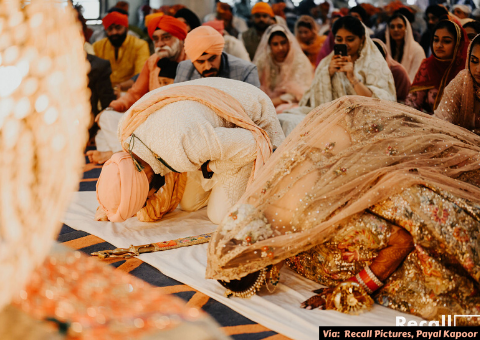
After the ceremony is done, you will see guests bowing down to ‘Guru Granth Sahib’. Even though it’s not necessary that you do the same, it’s nice to embrace these Sikh wedding traditions and if you do, the family members will find it respectful too!
Say ‘yes’ to the sweet
After the end of the formal part of the Sikh ceremony, sweet or ‘Kara Prashad’ is served. In both Hindu & Sikh cultures, you don’t say no to a Prashad as it’s consecrated and considered sacred. Made up of wheat flour, sugar, and ghee, it’s a delicacy. When it’s served to you, relish in its flavorsome flavor.
FAQ’s
Is Alcohol Served At Sikh Weddings?
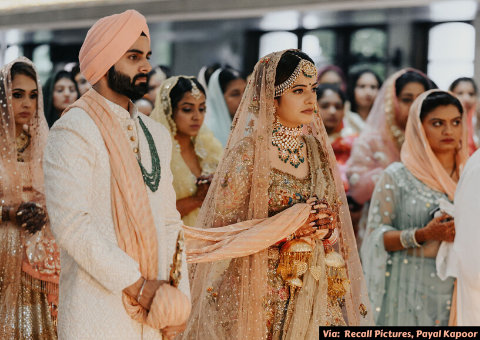
No, alcohol and meat are both prohibited at Sikh weddings and will not be served during the lunch at the Anand Karaj ceremony. Although, it is a part of the meals at other events like sangeet or reception. Both Hinduism and Sikhism frown upon liquor and animal meat being sold near a holy place, and since the Sikh wedding a.k.a Anand Karaj is held at a Gurudwara, both these products will not be a part of the menu.
How Long Is A Sikh Wedding?
The main ceremony, Anand Karaj, lasts for around 2 to 3 hours. It’s followed by lunch and a reception at night. Before the main day though, the Maiyan ceremony starts and the complete set of Sikh wedding traditions and the Anand Karaj can take around 2 to 3 days. Most Indian weddings are a 3-day long celebration, on average, and Sikh weddings are no different.
Can A Sikh Marry A Non-Sikh?
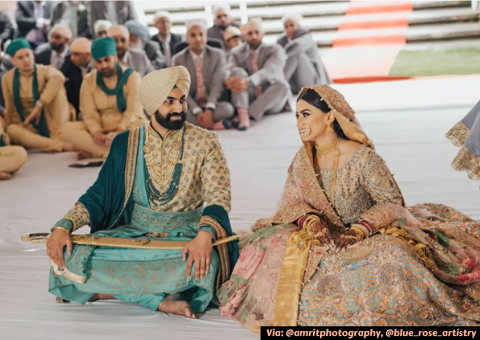
Yes, Sikhs can marry a non-Sikh, but the same can’t happen in a Gurudwara, where priests and the elderly in charge don’t allow inter-caste marriages. The reason is simple. Sikhs revere and believe highly in Guru Granth Sahib, and a non-Sikh doesn’t understand the importance and ideologies of the sacred text. When two people marry in Sikhism, their bond is blessed by Guruji and they declare their union in his presence. Since a non-Sikh doesn’t submit to the Guru, their marital bond nullifies. It’s safe to say that if you’re marrying a Sikh, you must submit and respect their faith. This doesn’t mean giving up yours, but to understand and be a part of the other person’s religious ideologies as well. How you reach a balance is totally up to you though.
What Color Should You Wear At A Sikh Wedding?
Except for white and red, you can wear any color. Whites are associated with widows in Sikh culture and are considered inauspicious, while red is generally reserved for the bride, and it’s considered respectful to not wear this shade to a Sikh wedding. You can wear bright shades like orange, bottle green, or yellow, or a soothing palette hue like pastels. It’s also mandatory that you cover your head through the Anand Karaj ceremony, so carry a dupatta, or stole with you. Men should carry a bandana or a handkerchief to cover their heads.

